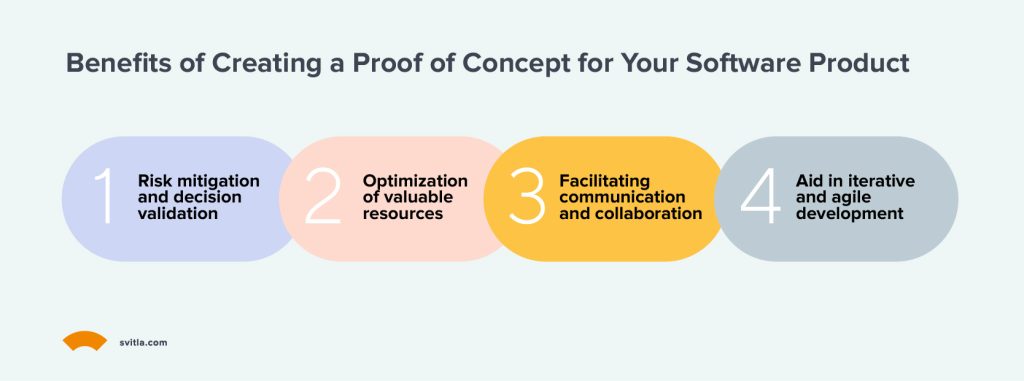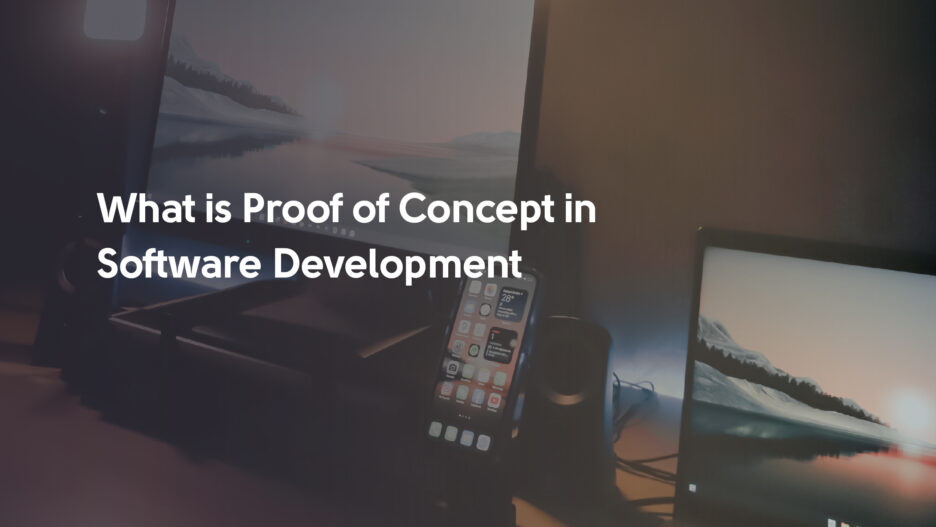Startups often find themselves at a crossroads in the ever-evolving software development landscape, facing a formidable challenge. Many fail to succeed due to their lack of initial testing among their target users, a critical misstep of jumping right into development without testing. Ultimately, this oversight results in wasted resources, misguided efforts, and failure to connect with the intended audience.
The Proof of Concept (PoC) has responded to these prevalent issues. This innovative approach serves as a litmus test for software developers and businesses, offering a methodical and strategic way to validate concepts before committing to full-scale development.
Many startups jump into full-scale software development only to realize their product doesn’t address customer needs. A proof of concept is a preliminary test version of a software application used to evaluate its viability and feasibility. Developing a PoC mitigates risk by validating the product-market fit before major resource investments.
This article will define proof of concept, distinguish it from a minimum viable product (MVP), outline the key benefits of creating a PoC, and provide a step-by-step guide to developing an effective PoC. With a data-driven PoC aligning stakeholder perspectives, teams can make informed go/no-go decisions on software projects.
PoC: Concept Definition and Distinguishing from MVP
PoC in software development stands as a foundational concept, playing a pivotal role in shaping the trajectory of innovative ideas. Let's delve into the essence of PoC and illuminate the crucial distinctions that set it apart from another prominent methodology – minimum viable product.
What is a proof of concept?
A proof of concept is a preliminary, experimental implementation that aims to validate the feasibility of an idea or concept. It is an initial exploration, providing tangible evidence that a particular concept can be implemented effectively. This phase is characterized by its focus on verifying key technical aspects, uncovering potential challenges, and assessing the viability of the proposed solution.
Key Attributes of PoC:
- Feasibility testing: PoC focuses on determining whether the core elements of an idea or concept are technically viable and can be implemented successfully.
- Limited scope: It typically involves a narrow scope, addressing specific functionalities or technical aspects rather than aiming for a comprehensive solution.
- Risk mitigation: One of its primary purposes is to identify and mitigate risks early in the development process, reducing uncertainties before substantial resources are invested.
- Quick iteration: PoC is designed for rapid iteration, allowing developers and stakeholders to quickly assess the potential of an idea and make informed decisions.
PoC vs. MVP: Navigating the Nuances
While PoC and MVP share the goal of validating ideas, they differ significantly in their scope, purpose, and the stage of the development process at which they are employed.
- Scope. PoC focuses on specific technical aspects or functionalities to test the feasibility of an idea. MVP encompasses a broader set of features, aiming to deliver a minimally viable version of the product to gather user feedback.
- Purpose. PoC primarily aims to validate technical feasibility, identify challenges, and reduce risks. MVP seeks to validate the concept and gather user feedback to refine and enhance the product.
- Stage of development. PoC is typically employed in the early stages of ideation and concept development. MVP is implemented when the concept has progressed, focusing on delivering a functional product to real users.
- User interaction. PoC has limited or no user interaction, primarily focusing on technical validation. MVP involves real users interacting with the product to gather insights and feedback.
In a nutshell, a proof of concept demonstrates a software application's basic functionalities, vital technical components, and overall workflow before full development. It evaluates technical capabilities and tests core hypotheses with hands-on prototypes. Rather than a saleable product, a PoC aims to supply evidence that the initial concept works and merits further maturation.
In comparison, a minimum viable product includes just enough features for early adopters to test and provide feedback. An MVP represents a production-ready solution, whereas a PoC indicates potential system viability only. A successful PoC may evolve into an MVP after implementation feedback.
Benefits of Creating a Proof of Concept: Mitigating Risks, Optimizing Resources, and Enhancing Collaboration
The strategic integration of PoC in software development brings forth many benefits, playing a pivotal role in steering projects toward success. Let's explore the multifaceted advantages of creating a PoC.
Risk Mitigation and Decision Validation
A PoC in software development is a proactive risk mitigation tool, allowing development teams to identify and address technical challenges early. By validating the feasibility of key technical aspects, teams can make informed decisions to mitigate potential roadblocks before full-scale development begins.
Before committing substantial resources to a project, a PoC empowers stakeholders to validate critical decisions. It provides tangible evidence of a concept's viability, enabling stakeholders to assess whether the proposed solution aligns with business objectives and technical requirements.
Optimization of Resources
Creating a PoC ensures that resources are allocated efficiently. By focusing on specific functionalities or technical elements, development teams can channel their efforts into the core aspects that require validation, avoiding unnecessary development of non-essential components.
Identifying and addressing challenges early in the development process prevents allocating resources to a concept that may face insurmountable obstacles. This, in turn, leads to cost savings by avoiding investment in a concept with inherent flaws.
Facilitating Communication and Collaboration
A PoC is a tangible manifestation of the conceptualized idea. It visually represents the proposed solution and facilitates effective communication between developers and stakeholders. This alignment ensures that the development trajectory is in harmony with stakeholder expectations.
The collaborative aspect of PoC development fosters a shared understanding among team members. Developers can leverage the PoC to convey technical intricacies to non-technical stakeholders, promoting a collaborative environment where ideas are exchanged transparently.
Quick Iteration and Agile Development
PoC encourages a rapid prototyping approach, allowing teams to iterate quickly and refine the concept iteratively. This agility is instrumental in adapting to evolving requirements and incorporating feedback effectively.
The principles of agile development are inherently embedded in the PoC process. It encourages an open-minded, adaptive, and iterative approach, aligning with the agile mindset emphasizing continuous improvement and learning from mistakes.

How to Create a Proof of Concept: Key Steps
Embarking on creating a Proof of Concept requires a systematic approach that aligns technical exploration with overarching project goals. Here are the key steps to guide you through the process of crafting a robust PoC:
1. Define Clear Objectives
Map out the project goals and the specific challenges the PoC aims to address. This clarity ensures that the PoC aligns with the overarching objectives of the software development initiative.
At this stage, it’s vital to establish measurable success criteria that will serve as benchmarks for evaluating the effectiveness of the PoC. These criteria should be directly tied to the objectives, providing a quantifiable means of assessing the PoC's impact.
2. Identify Key Functionalities
Identify and prioritize the core functionalities or technical aspects that require validation. Concentrate on the elements that pose the highest technical risk or are integral to the overall project's success.
Also, define the scope of the PoC by outlining its limitations. Delineate what the PoC aims to achieve and what aspects it does not cover. This scoping exercise helps manage expectations and ensures a focused development effort.
3. Select Appropriate Technologies
Choose the appropriate technologies and tools for building the PoC, considering factors like scalability, compatibility with the intended software solution, and the ability to provide rapid prototyping.
Conduct a feasibility assessment to validate that the selected technologies can effectively address the identified challenges. This step is crucial for ensuring that the PoC aligns with the technical requirements of the broader project.
4. Develop a Prototype
A prototype showcases the selected functionalities. Prioritize rapid prototyping to generate a tangible representation of the PoC quickly. This iterative approach allows for swift adjustments based on feedback.
An iterative development process is preferable. It allows you to incorporate feedback from stakeholders and development team members and use each iteration to refine the prototype, ensuring it accurately reflects the intended solution.
5. Gather and Analyze Feedback
Collect input from stakeholders, including both technical and non-technical members. Evaluate the PoC against the defined success criteria and gather insights into its usability, feasibility, and alignment with project goals.
Establish an iterative feedback loop, allowing for continuous refinement of the PoC based on the feedback received. This collaborative approach enhances the quality of the PoC and increases its chances of success.
6. Create Documentation and Evaluation of the PoC
Create comprehensive documentation that captures the process followed, technologies used, and decisions made during PoC development. This documentation serves as a valuable resource for future development phases.
Conduct a thorough evaluation of the PoC against the predefined success criteria. Analyze whether the PoC successfully addresses the identified challenges and aligns with the project's goals.
Wrapping up
As we traversed the intricacies of proof of concept in software development, it became evident that it is not just a testing ground – it's a cornerstone of informed decision-making and triumphant project outcomes.
Adding proof of concept to a project involves addressing a crucial challenge: the risky journey without first testing with the target audience. At Svitla Systems, PoC is not merely a phase; it's a calculated approach to making sound decisions about new software products, significantly minimizing risks, and ensuring the delivery of solutions that resonate with users.
Contact us to build your startup or enhance your existing product with software development best practices like proof of concept.





![[Blog cover] SEO optimization best practices](https://svitla.com/wp-content/uploads/2025/05/Blog-cover-SEO-optimization-best-practices-560x310.jpg)